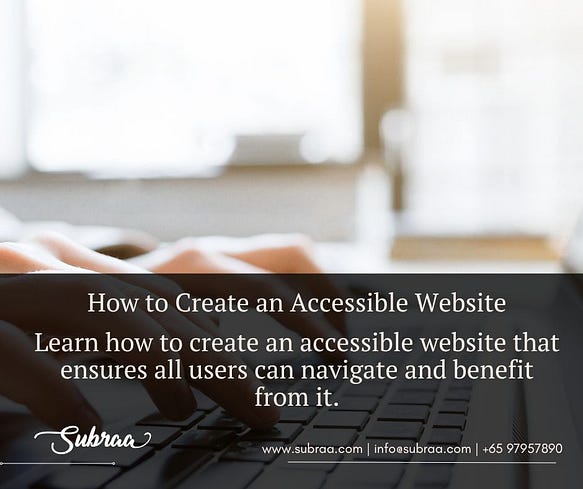The Importance of Accessibility in Modern Web Design Practices — Subraa

Creating an accessible website is a crucial aspect of modern website design, ensuring that all users, regardless of their abilities, can interact with your content effectively. As a Singapore web designer, incorporating accessibility into your projects not only broadens your audience but also enhances user experience and complies with legal standards.
Understanding Web Accessibility
Web accessibility refers to designing websites and online tools in a way that people with disabilities can use them. This includes individuals with visual, auditory, motor, and cognitive impairments. The Web Content Accessibility Guidelines (WCAG) are the standard guidelines for making web content accessible to all users.
Key Principles of Accessible Website Design Information and User Interface:
Provide text alternatives for non-text content. For instance, use alt text for images and transcriptions for audio files.
Ensure that content can be presented in different ways without losing information or structure, such as through a screen reader.
Operable User Interface and Navigation:
Make all functionality available from a keyboard. Some users rely on keyboards instead of a mouse, so ensure all interactive elements are accessible via keyboard commands.
Provide users with enough time to read and use content. This can involve giving users the option to pause or extend time limits on certain actions.
Understandable Information and Operation:
Make text content readable and understandable. Use simple language and provide definitions for complex terms.
Ensure web pages operate in predictable ways. Navigation mechanisms should be consistent throughout the website, making it easier for users to understand and predict how to use your site.
Robust Content and Reliable Interpretation:
Maximize compatibility with current and future user tools, including assistive technologies. Use clean HTML and CSS codes to ensure that the website functions well across different devices and platforms.
Practical Steps for freelance Web Designers
Use Semantic HTML: Utilizing semantic HTML5 elements like <header>, <nav>, <main>,<article>, and <footer> helps screen readers and other assistive technologies understand the structure and importance of content.
Color Contrast: Ensure sufficient contrast between text and background colors.
Responsive Design: Create a responsive website design that works on all devices, including desktops, tablets, and smartphones. This approach not only improves accessibility but also enhances overall user experience.
Accessible Forms: Design forms with clearly labeled fields and ensure that each field is easily navigable via keyboard. Implement error messages that are easy to understand and correct.
Multimedia Accessibility: Provide captions and transcripts for audio and video content. This helps users with hearing impairments and those who prefer reading over listening.
Integrating accessibility into your website design is not just about meeting legal requirements; it’s about creating a more inclusive digital world. As a web designer in Singapore, you have the power to make the internet a more accessible place for everyone. By following the principles and practical steps outlined above, you can ensure your websites are usable by all, providing a better experience for every visitor.
Look here: https://www.subraa.com/



Comments
Post a Comment